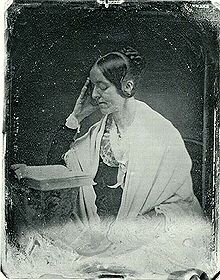‘The Sacred Marriage’, by Margaret Fuller
Even more than most New England Transcendentalists, Margaret Fuller (1810–1850) was ahead of her time. Her poem ‘The Sacred Marriage’, which appeared at the end of her book Women in the Nineteenth Century (1845), describes the optimal state of the human being as involving a marriage of two elements, a Lunar (feminine) principle and Solar (masculine) principle. In a characteristically Transcendentalist way, Fuller sees this psychological androgyny as more than just a way to obtain optimal psychological functioning; rather, the implications extend to ones spiritual development: the sacred marriage is part of the soul’s gradual deification.
As far as I know, neither Fuller nor other New England Transcendentalists were familiar with the literatures of spiritual alchemy and Rosicrucianism, which describe the marriage of masculine and feminine principles in similar terms. New England Transcendentalists, however, were familiar with the works of esoteric Christian writers like Swedenborg and Jacob Boehme.
Fuller also had a penchant to describe human psychology in terms of figures from Greek mythology, i.e., in a way that we might today call “achetypal psychology.” At least one influence in this regard may have been the English Platonist, Thomas Taylor, whose translations and commentaries on Platonist and Neoplatonist writings were popular in America at the time.
The Sacred Marriage
Margaret Fuller
(Source: Fuller, Margaret. Women in the Nineteenth Century. New York: Greeley & McElrath, 1845. App. H (pp. 200-201).
And has another’s life as large a scope?
It may give due fulfilment to thy hope,
And every portal to the unknown may ope.
If, near this other life, thy inmost feeling
Trembles with fateful prescience of revealing
The future Deity, time is still concealing.
If thou feel thy whole force drawn more and more
To launch that other bark on seas without a shore;
And no still secret must be kept in store;
If meannesses that dim each temporal deed,
The dull decay that mars the fleshly weed,
And flower of love that seems to fall and leave no-seed—
Hide never the full presence from thy sight
Of mutual aims and tasks, ideals bright,
Which feed their roots to-day on all this seeming blight.
Twin stars that mutual circle in the heaven,
Two parts for spiritual concord given,
Twin Sabbaths that inlock the Sacred Seven;
Still looking to the centre for the cause,
Mutual light giving to draw out the powers,
And learning all the other groups by cognizance of one another’s laws:
The parent love the wedded love includes,
The one permits the two their mutual moods,
The two each other know mid myriad multitudes;
With child-like intellect discerning love,
And mutual action energizing love,
In myriad forms affiliating love.
A world whose seasons bloom from pole to pole,
A force which knows both starting-point and goal,
A Home in Heaven,—the Union in the Soul.

 The Immortal I
The Immortal I
[…] from David Bowie. When I studied literature, I learned about androgyny from Margaret Fuller, Carl Jung, Adrienne Rich, and beyond. Gender fluidity was the special mark […]
Androgyny as a Leadership Concept and Beyond – Sisyphus in the Stacks
June 15, 2021 at 6:18 pm
[…] ‘The Sacred Marriage’, by Margaret Fuller […]
Transcendentalism. Reading. | Satyagraha
June 5, 2022 at 10:56 pm